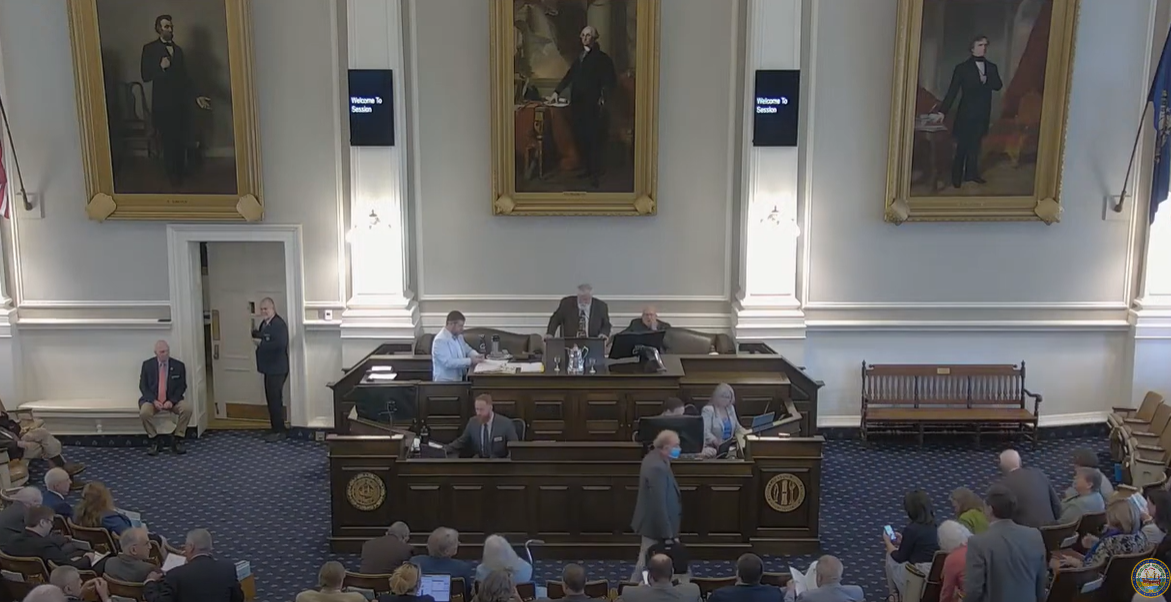By GARRY RAYNO, InDepthNH.org
CONCORD — Expanding the Education Freedom Account failed to graduate from the 2024 legislative session Thursday failing on a 185-168 vote of the House.
House and Senate negotiators last week reached agreement on expanding the program that would have increased the income threshold for a family of four by $23,400 beginning next school year.
The Senate had approved the compromise on House Bill 1665 on a partisan 14-10 vote, but the House voted against the program it had approved by one vote earlier this session.
During the House debate, Rep. David Luneau, D-Hopkinton, noted 95 percent of children participating in the program were either in private or religious schools, or homeschooling, not in public schools when the program began.
And he said the House has not been interested in preventing fraud by putting guardrails on the program while the Department of Education has attempted to obstruct the Legislative Budget Assistant’s Audit investigation in the program.
And Luneau said the program has approved a vendor that is a member of a hate group that is teaching students.
“If all that is not enough to overcome, you will hear how wildly successful this taxpayer give-away program is,” Luneau said. “Please vote no.”
Rep. Rick Ladd, R-Haverhill, said the program has been “a life-changing experience for many children who had unsuccessful experiences in the public school system.”
Increasing the income threshold would allow many middle class families under the burden of inflation, low-wage growth and increasing debt to provide an alternative education for their children, he said.
“This will get more kids involved, it will open the doors to 60 percent of the children in the state,” Ladd said.
But Rep. Mel Myler, D-Hopkinton, said the goal for the proponents of the EFA program is to make it available to every child in the state regardless of the family’s income.
He said the program was established to help folks in poverty to provide an alternative education to their children, while expanding the income threshold changes is the intent.
There is no other state funded program with as little accountability and oversight as this $60 million program, Myler said, noting the intent to draw more and more money away from publicly supported public schools.
In the Senate, Sen. Timothy Lang, R-Sanbornton, said “Over 4,200 students have benefitted from it, and we want more families to be eligible for school choice. This bill expands school choice to more hard-working New Hampshire families, lowers administrative costs, and maintains property tax relief for local school districts. Expanding this program to more families gives more options to more students.”
The compromise would have increased the income threshold from 350 percent of the federal poverty level to 425 percent, lowered the administrative costs from 10 percent to 8 percent and extended the phase out for public schools that lose students to the EFA program for three more years.
Last month, the House killed the Senate’s EFA expansion bill, Senate Bill 442, but the Senate replaced the content of the House’s plan with the content of its bill.
The Senate approved bill lowers the eligibility for the program from the House approved 500 percent to 400 percent of the federal poverty level, reducing the estimated increase in state costs to about $55 million from $70 million to $80 million annually.
The EFA program provides an average per pupil grant of $5,255 to about 4,700 students this school year, up from the 1,600 students when the program began three years ago when the average grant was $4,952.
Increasing the eligibility cap to 500 percent of the federal poverty level would cap the income of a family of four at $156,000 and $102,000 for a parent and child household based on federal 2024 figures.
The current rate of 350 percent limits income to $109,200 for a family of four and $71,540 for a family of two.
At the 400 percent threshold, a family of two would be able to earn up to $81,760 and a family of four up to $124,800.
And at 425 percent, a family of four could earn up to $133,600 annually, and a two-member family could earn up to $86,870.
The federal government estimates the median income in New Hampshire for a family of four is $133,447.
The state money for the program comes from the Education Trust Fund, which also pays for state adequacy grants, some special education and school building aid, and other education items.
The fund currently has a surplus of about $212 million.
The controversial program was sold as an alternative for lower income parents to send their child to a more appropriate educational environment for their learning abilities other than public schools.
However, about 95 percent of the students in the program were not in public schools when they applied for the state grants and instead were in private or religious schools or in homeschooling.
The increase in eligibility has not significantly increased the number of students leaving public schools but has increased subsidies to attend private and religious schools or homeschooling programs. The majority of the EFA grant money goes to private Catholic schools as is true throughout the country where 29 states have some form of voucher programs allowing parents to use public money for alternatives to public schools, which continue to house the vast majority of school-age students.
States that have no eligibility cap have seen the program explode with non-public school students seeking grants that have nearly bankrupted Arizona and put Ohio public schools in peril.
When the program was first proposed in New Hampshire there was no income cap, but when the program was first approved as part of the 2021-2022 biennial budget it included a 300 percent poverty limit, which was raised to 350 percent for the current school year.
Garry Rayno may be reached at garry.rayno@yahoo.com.





